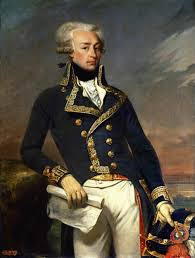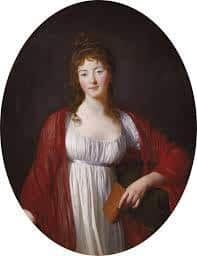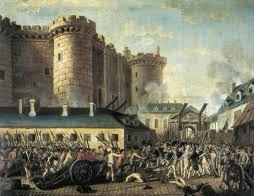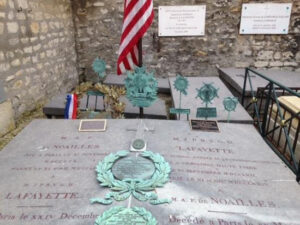In the footsteps of General Lafayette
Today, any American coming to Paris for the first time, will want to see the Eiffel Tower. But did you know that in Lafayette’s time, any American coming to Paris wanted to meet General Lafayette?
Lafayette’s long life in a nutshell
General Lafayette is one of the few men in the world who lived an adventurous life.
Lafayette enjoyed a fantastic romantic life and an unprecedented soldier’s life: fighting in the American independence war, leading the National Guard during the French Revolution, spending time in prison and known to be the father of the Declaration of Human Rights in France.
Let us explore the life of this man, who worked with King Louis XVI (Louis the Great) and Queen Marie Antoinette, Napoleon Bonaparte, George Washington and Benjamin Franklin.
We will discover a man who believed in egalitarian rights, long before it became a common right in all democratic countries.
His youth
Marie Joseph Paul Roch Gilbert de Motier, Marquis de Lafayette was born in the center of France in the region named Auvergne in 1757 in a wealthy noble family.
His father died in war when he was a toddler.
Lafayette became a soldier like his father and an officer at the age of 13.
When he was 17, he married the 14 year-old Adrienne de Noailles. She descended from a very wealthy influential noble family. The family were courtesans in the Royal Court.
After their wedding, he was offered a well-paid position by the king of France that he declined, as he saw himself as a soldier, not a courtesan nor a politician.
His ascension
Lafayette convinced the king of France that the independence war in America was worthwhile. The young soldier left France at the age of 19, with a ship full of cannons and ammunition, ready for war.
Lafayette won important battles and came back to France where he was celebrated like a star. He remained famous until his death and far beyond.
His challenges:
During the French Revolution, Lafayette clearly chose the side of the people, but being at the head of the National Guards, he was not trusted by neither the king nor the people.
After the King and the Queen tried to escape Paris and flee from France, Lafayette left the country, like many others at that period… Unfortunately, he was caught by the Austrian guards who threw him in prison for 5 years.
When Napoleon Bonaparte rose to power, Lafayette was released.
Napoleon wanted to work with Lafayette, but again, Lafayette declined the offer to become a courtesan. We believe that these two powerful men were jealous of each other.
Napoleon wanted Lafayette’s popularity.
Lafayette wanted Napoleon’s power.
A French Star in the United States
Lafayette retired for a while and became a farmer, like his hero, George Washington.
But soon, he came back to politics and became involved in the different revolutions that took place in France after the fall of Napoleon Bonaparte.
Lafayette became a freemason and used his connections in France and the US to strengthen the ties between the two countries.
Independence Day Ceremony in Picpus Cemetery, Paris
At the end of his life, Lafayette was invited as a guest star to the United States. He toured through the country and many sites.
Buildings and institutions were named after him.
Lafayette died in 1834, after he caught a cold during a funeral of his friend.
He was buried in the Parisian cemetery of Picpus.
Until today, every year on the Independence Day, a small military ceremony takes place, led by the US Ambassador.
A peek into the intimate life of Lafayette
Lafayette grew up in the countryside, playing with the children of farmers and enjoying an outdoorsy life.
He married at the age of 17.
Even though the marriage with Adrienne de Noailles was a commonly arranged marriage, it was a happy marriage full of Love.
They had 3 daughters and one son.
His son was named George Washington de Lafayette.
When he was presented at the court in Versailles, he was not as delicate as most men.
The first and last time he was told to dance with the Queen, he stepped on her feet, which she never forgave him.
Lafayette spent a lot of time in the United States.
His wife remained in France. He would write her letters, that she would read out loud during receptions she gave where influential people from high society in France would come. So it was through Adrienne that the deeds and liberal opinions of Lafayette became known.
When he was jailed in the Austrian prison for 5 years, his loving wife decided to join him, with two of their daughters. Adrienne was jailed and suffered.
Actually, the jail time declined the health of Adrienne, she died a few years later.
Lafayette loved his wife dearly, but like most men in his time, he had several mistresses.
One of them was the beautiful Adelaide de Simiane, who’s husband also fought in America but who was homosexual. As Adélaide was among the most beautiful women in France, her husband was extremely jealous, despite him preferring men.
He died in a hunting accident but gossip said he actually shot himself because he noticed the passion between Lafayette and his wife.
Adrienne, Lafayette’s wife, accepted the relationship between her husband and his mistress and even allowed the presence of Adelaide in their house.
Lafayette,after many years, broke off the relationship because he and his mistress had different political ideas, but they remained friends until Lafayette’s death
Lafayette and his allegiance to America
In 1777 Lafayette sailed to America for the first time.
When the ship accosted, he and his men crossed the swamps in South Carolina until they reached Charleston, where they sold their cannons and ammunition to the militia.
Meeting George Washington
With the money, they bought horses and guns and traveled to Philadelphia where Lafayette met with George Washington for the first time.
Lafayette was given the command over a group of 17000 volunteers.
Lafayette was injured.
During the battle that followed, Lafayette was shot in his leg, but managed to push his men to a victory.
He was invited to recover on the farm of George Washington.
From then on the men became extremely close and Lafayette considered George Washintong as his spiritual father. Washington considered Lafayette as his son. Indeed, Lafayette had his own room in the Washinton’s house, like a real son.
Meeting Benjamin Franklin
Lafayette also met with Benjamin Franklin, in Paris and in America.
They became very close.
Benjamin Franklin helped Lafayette write the French declaration of Human Rights.
The last visit to the United States took place in 1824. The Marquis was invited and he brought his son, George Washington. They arrived in New York where they were welcomed by thousands of admirers. The first thing he did was to visit the tomb of his spiritual father, George Washington.
He then toured the country for a year, visiting battlefields, meeting people and strengthening the ties with the American freemasons.
It is since his last visit to the US that universities, schools, sites and streets were named after him.
To understand the influence of Lafayette, let us just remember that a US squadron of pilots that fought in Europe during World War I, was called the Lafayette squadron.
Because like Lafayette, these pilots choose to risk their lives far away from their own country, to fight for freedom worldwide.
More symbolically even, part of this squadron was an afro-american pilot, nicknamed “ the black Swann”.
He was the first coloured pilot in the United States. Lafayette had all his life been against slavery and had always fought against racism.
The subject of slavery often came up in conversations with George Washington and Benjamin Franklin, who both had slaves.
General Lafayette and the French Revolution
Lafayette was a huge supporter of the French revolution. It is only later, when the radical wing of the people revolution attacked him, and thus, his position became compromised.
Just before the revolution started, France’s finances were really bad, partly because of the cost of France’s mismanagement, uncalculated contributions to the independence war in America, but mainly for the huge expenses of the King’s Palace and his Royal family.
We can visit Versailles together to see where these huge amounts of money are spent on.
It is worth the trip 😉
Lafayette was elected by the region where he was born as a member of the Assembly. As such he denounced the spending behavior of the Queen and her friends. He was the first to “indirectly” attack the Queen.
Read more about the extravagent life of Queen Marie Antoinette.
Lafayette imagined a future National Assembly, representing all the French people, should be put in place.
A short time afterwards, he became the vice president of the newly founded National Assembly as well as the military leader of 40.000 men of the National Guards, a military institution.
In July 1789, after the Bastille was stormed, he supervised the demolition. He actually took one of the stones of the torn down fortress and put it above the main entrance of his chateau as a reminder.
Later that year, a Parisian mob of women, armed, decided to march on the Versailles Palace, protesting against the lack of food.
Lafayette hurried to calm down the crowd and to protect the Royal family. He made a mistake by thinking that everybody calmed down… and he went to sleep. In the middle of the night, the women stormed the palace and killed several national guards.
The Royal family was saved, but Lafayette should have never gone to bed.
He accompanied the Royal family to Paris, not knowing that they would never see Versailles back again.
In Paris, he advised the king to work together with the revolutionairs. The king obeyed, but actually did not agree with Lafayette. This led to the secret escape of the royal family and eventually to their tragic end.
As Lafayette failed in his mission to protect and to guide the royal family, the most radical factions of the Revolution turned against him and he had to flee the country.
Lafayette remained politically involved in later stages in his life, but we still remember him as one of the main figures of the French revolution.
Remembering Lafayette
My tour in Paris about Lafayette
Visiting the palace of Versailles, the newly reopened museum Carnavalet in Paris, strolling by the Bastille will bring back many memories and stories about the Marquis.
We can go and see the impressive monument at Saint Cloud, built to honor the “Lafayette squadron” and of course visit the Picpus cemetery where Lafayette’s was buried.
Read about Flora Goldenberg.
Conclusion
Lafayette’s life was so full of events, acts and courage because he believed very strongly in his opinions. He was an avant-garde. He had a good vision of freedom. He was years ahead of his time, and sometimes he was misunderstood. But those who did understand him, trusted him to the fullest.
PS: If you are touring in France and you happen to be in the beautiful region of Auvergne, in the center of the country, you could visit the Chateau Lafayette, where the Marquis was born.
If you enjoyed my article, please read more about other famous figures such as Alfred Dreyfus






